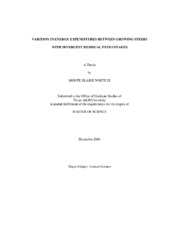| dc.description.abstract | Objectives of this study were to determine if variation in energy expenditures
contributed to differences in feed efficiency between low and high RFI steers. Nine
steers with the lowest and highest residual feed intakes (RFI) were selected from 169
Braunvieh-sired crossbred steers that were individually fed a pelleted roughage-based
diet for 77 d. Following the RFI measurement period, heat production (HP)
measurements were obtained using indirect calorimetry while steers were fed the same
roughage diet (RD) and on a high-concentrate diet (CD). Linear regression analyses of
log HP or retained energy on ME intake were used to determine energy partitioning.
Motion and lying activity were measured concurrently with HP on the RD and CD.
During the RFI measurement period, low RFI steers had lower (P < 0.01) RFI (-1.7 vs.
1.6 ± 0.17 kg/d), DMI (7.7 vs. 10.2 ± 0.42 kg/d) and feed:gain ratio (F:G; 7.2 vs. 10.6 ±
0.60), but similar final BW and ADG compared to high RFI steers. However, there were
smaller differences in DMI (8.4 vs. 9.7 ± 0.38 kg/d; P < 0.05; 7.56 vs. 8.16 ± 0.31; P =
0.19) and F:G (10.0 vs. 10.9 ± 0.40; P = 0.36; 6.5 vs. 7.5 ± 0.30; P < 0.05) between low
and high RFI steers, on the RD and CD, respectively. ME for maintenance (MEm; kg .75
d–1) and the partial efficiencies of ME used for maintenance and gain were similar for
low and high RFI steers. Likewise, no differences were found in fasting HP or fed HP.
Motion activity was lower (P < 0.05) for low RFI steers compared to high RFI steers
during fasting HP. Covariate analysis of HP at the same activity level yielded similar
results. At slaughter, weights of lung and trachea (P < 0.05), spleen (P < 0.05) and
adrenal gland (P = 0.07) were higher for low RFI cattle. The lack of differences in
energy partitioning between divergent RFI steers may have been the result of alterations
in feeding behavior or stress imposed by adapting steers to calorimetry chambers. | en |


